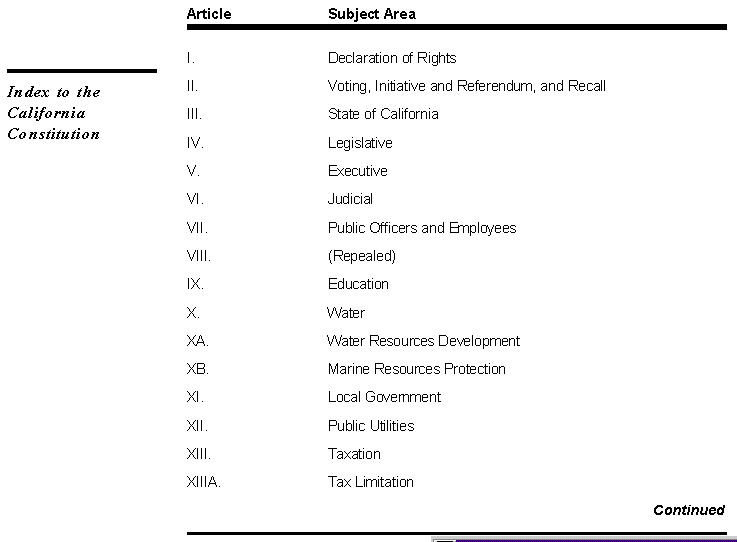
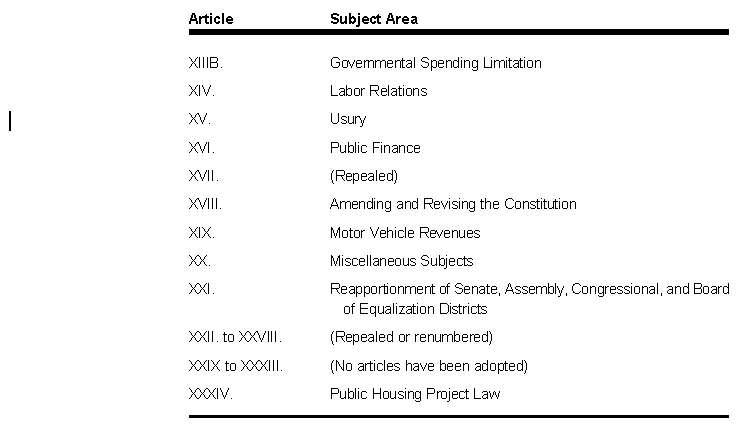
 Legislative Analyst's Office
Legislative Analyst's Office
Understanding the basic structure of California's governmental sector is an important prerequisite for understanding the fiscal and policy problems and issues facing the state, their implications, and the various options for addressing them.
There are a variety of different types of governmental entities in California. These include both the state government and local governments, such as counties, cities, special districts, redevelopment agencies, K-12 school districts, and community college districts. Local entities vary greatly by size and nature. For example, special districts can range from small water districts to large multi-county air quality districts, and from self-governing to being subordinate units run by other entities like counties.
In 1991-92, there were nearly 7,000 governmental entities in California, including 58 counties, nearly 470 cities, over 380 redevelopment agencies, more than 4,800 special districts, and over 1,100 school districts.
For more information about these types of local entities, see the chapter on Local Government later in this document.
The state government and its three branches--legislative, executive, and judicial--are provided for in the California Constitution. Local governmental entities can be created only in accordance with state law, and certain powers are constitutionally guaranteed to counties and cities. Except for constitutional provisions, state law prevails over local law when these conflict or when the two cover similar subject matter. The Constitution provides for three classes of county and city government--general law, charter, and consolidated city and county.
California's first Constitution was adopted in 1849, shortly before the state was admitted to the Union in 1850. A new Constitution was adopted in 1879. Since then, the State's Constitution has been changed literally hundreds of times. The Constitution currently has provisions covering a wide range of topics, including governmental organization, educational funding, taxation, government spending, and issuance of bond debt.


There are three ways to change California's Constitution--by amendment, by constitutional convention, and by revision proposed by the Legislature. All of these alternatives require majority vote approval by the electorate.
A Constitutional Revision Commission was statutorily established in 1993 to review and propose to the Legislature any needed changes to the current Constitution. The Commission's report is due in August 1995.
The relative roles of California's state and local governments in providing public services differs considerably by program area and in terms of such basic dimensions as program funding, decision-making authority, administration, and service delivery.
The figure shows how program involvement differs by one particular dimension--direct government spending. It shows the percent distribution of total combined state and local direct government spending, by program area and level of government. The term "direct spending" refers here to the point at which spending on programs actually occurs, and does not reflect intergovernmental transfers of funds for program support. For example, when the state provides funds to localities who in turn directly spend them on programs, this is shown as local spending, not state spending. The data are from the U.S. Department of Commerce for 1991-92, the most recent year for which comprehensive state-local data are available.
About 35 percent of all direct spending on programs is state spending and about 65 percent is local. The state-local split varies considerably, however, by program area.
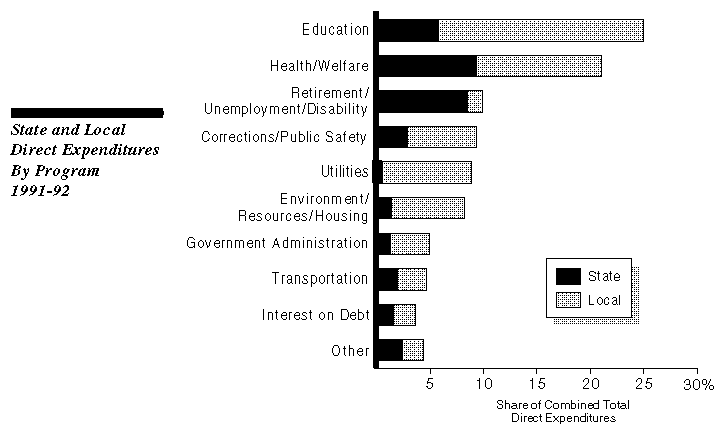
For example, about 25 percent of combined state-local direct spending is for educational services, of which over three-fourths is local and close to one-fourth is state. In contrast, slightly over one-fifth of all spending is for health and welfare, of which about 45 percent is directly spent by the state and 55 percent by localities. In the case of corrections and public safety, this accounts for about 10 percent of direct spending, of which 30 percent is state and 70 percent is local.
Different state-local shares would apply for other dimensions of program involvement, such as ultimate funding sources, policy decision-making, administration, and service delivery responsibility.
When considering options for addressing budgetary problems and policy issues using taxes and bond financing, state and local decision-makers must work within the context of certain approval or voting requirements.
The approval or voting requirements for state and local taxes and bonds are varied and involve a mix of statutory and constitutional provisions.
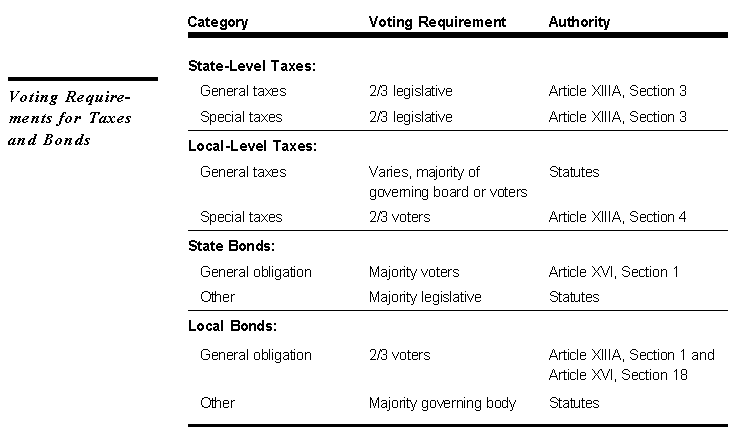
In the case of state and local bonds, the category "other" includes revenue bonds, lease-payment bonds, and certificates of participation.
Since Proposition 13 in 1978, initiatives covering a wide range of subject areas have been enacted that have significant fiscal implications for California's state and local governments.
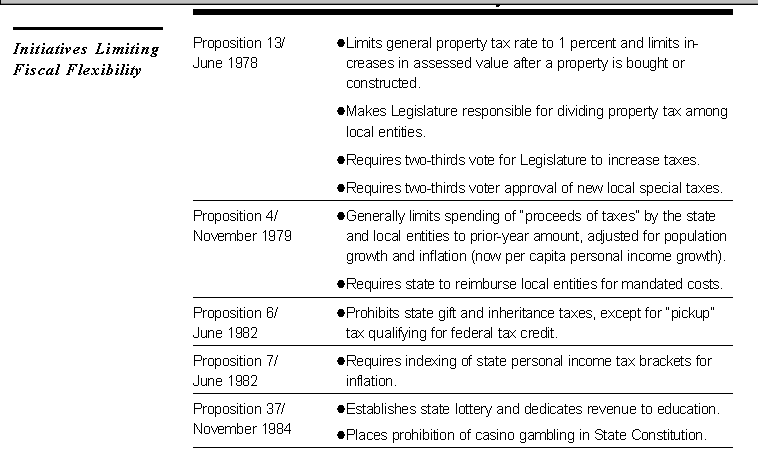
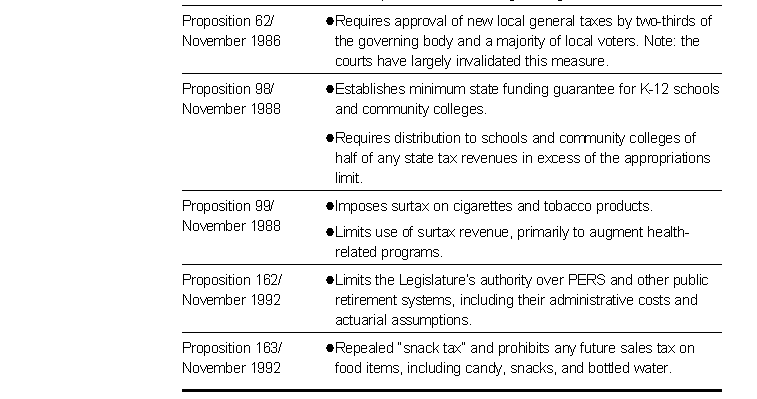
Voter approval is required to amend or repeal an initiative once it has been adopted by voters, unless the measure provides otherwise. Thus, initiatives can limit the Legislature's ability to modify the fiscal environment, especially in the face of new fiscal developments, and also restrict localities' flexibility.
This lack of flexibility sometimes can cause "second best" alternative actions to be considered in order to address fiscal and policy issues.